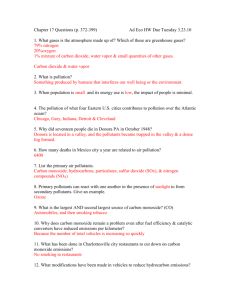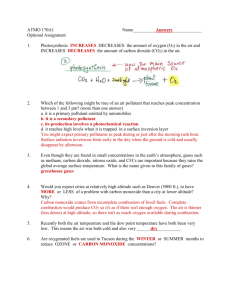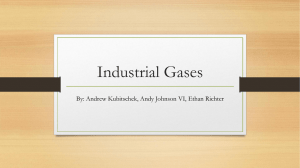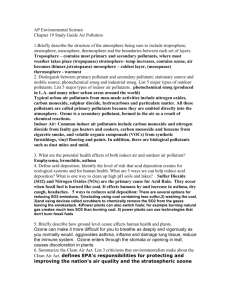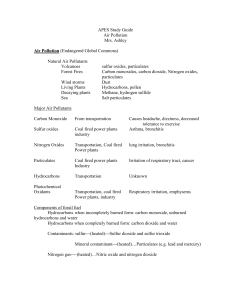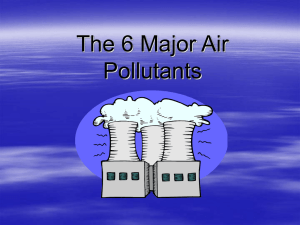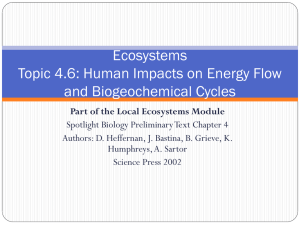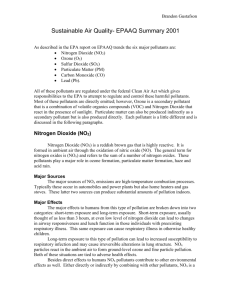Test Unit 7 Answers MC Ch 20 & 21 Atmosphere
advertisement
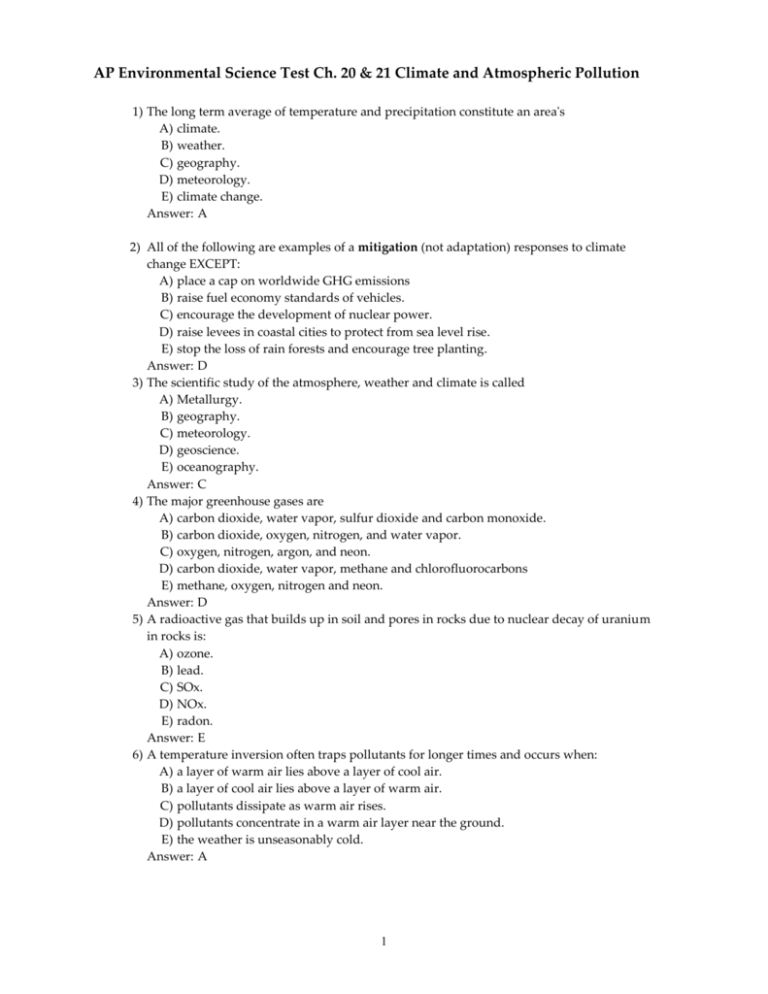
AP Environmental Science Test Ch. 20 & 21 Climate and Atmospheric Pollution 1) The long term average of temperature and precipitation constitute an area's A) climate. B) weather. C) geography. D) meteorology. E) climate change. Answer: A 2) All of the following are examples of a mitigation (not adaptation) responses to climate change EXCEPT: A) place a cap on worldwide GHG emissions B) raise fuel economy standards of vehicles. C) encourage the development of nuclear power. D) raise levees in coastal cities to protect from sea level rise. E) stop the loss of rain forests and encourage tree planting. Answer: D 3) The scientific study of the atmosphere, weather and climate is called A) Metallurgy. B) geography. C) meteorology. D) geoscience. E) oceanography. Answer: C 4) The major greenhouse gases are A) carbon dioxide, water vapor, sulfur dioxide and carbon monoxide. B) carbon dioxide, oxygen, nitrogen, and water vapor. C) oxygen, nitrogen, argon, and neon. D) carbon dioxide, water vapor, methane and chlorofluorocarbons E) methane, oxygen, nitrogen and neon. Answer: D 5) A radioactive gas that builds up in soil and pores in rocks due to nuclear decay of uranium in rocks is: A) ozone. B) lead. C) SOx. D) NOx. E) radon. Answer: E 6) A temperature inversion often traps pollutants for longer times and occurs when: A) a layer of warm air lies above a layer of cool air. B) a layer of cool air lies above a layer of warm air. C) pollutants dissipate as warm air rises. D) pollutants concentrate in a warm air layer near the ground. E) the weather is unseasonably cold. Answer: A 1 7) Which of the following is true about stratospheric ozone? A) It is dangerous to people with respiratory illness. B) It is increasing due to human population. C) It is important technologically because it receives radio waves. D) It absorbs ultraviolet light. E) It is being depleted by carbon dioxide produced through burning of fossil fuels. Answer: D 8) The chemical that reacting with and causing the destruction of stratospheric ozone is: A) chlorofluorocarbons (CFC’s). B) dry cleaning fluids. C) carbon dioxide. D) oxygen. E) hydrocarbons. Answer: A 9) Greenhouse gases like carbon dioxide and methane differ from atmospheric gases like oxygen and nitrogen in that: A) greenhouse gases absorb and then reradiate infrared radiation towards the Earth's surface. B) non-greenhouse gases reflect solar radiation. C) greenhouse gases reflect solar radiation back into space. D) greenhouse gases produce heat from chemical reactions. E) non-greenhouse gases absorb greenhouse gases. Answer: A 10) Which of the following is the major source(s) of chlorofluorocarbons? A) combustion of coal. B) microbial fermentation (anaerobic breakdown) of organic matter in coal mines, oil well, and livestock. C) emissions from automobiles and chemical fertilizers. D) evaporation from the Earth's oceans. E) refrigerants, solvents, fire retardants, and aerosol propellants. Answer: E 11) The major anthropogenic source(s) of excess methane in the atmosphere is/are A) refrigerants, solvents and fire retardants. B) microbial fermentation (anaerobic breakdown) of organic matter in coal mines, oil wells, wetlands, and livestock C) emissions from automobiles and chemical fertilizers. D) evaporation from the Earth's oceans. E) combustion of fossil fuels. Answer: B 12) The major anthropogenic source(s) of excess nitrous oxide in the atmosphere is/are A) refrigerants, solvents and fire retardants. B) microbial fermentation of organic matter in coal mines, oil well, and livestock. C) emissions from automobiles and chemical fertilizers. D) evaporation from the Earth's oceans. E) combustion of fossil fuels. Answer: C 13) Which of the following is true concerning global warming and polar regions? A) there is little evidence of melting of glaciers or thinning of polar ice. B) there is no difference in the degree of warming and latitude. C) the effect of global warming is less at the poles because they are so cold. D) recent temperature increases have been greatest in polar regions. E) the length of winters in polar regions is increasing. 2 Answer: D 14) The primary goal of the Kyoto Protocol is to: A) reduce production of greenhouse gases to below 1990 levels. B) ban the use of fossil fuels completely. C) stop the further use of CFC’s worldwide. D) offer financial incentives for “carbon neutral” sources of energy. E) stabilize the amount of carbon monoxide CO in the atmosphere. Answer: A 15) The greatest carbon dioxide emissions from fossil fuels burning originates in A) Europe. B) North America. C) Asia/Pacific. D) Africa. E) the Middle East. Answer: C 16) Which of the following is likely to occur if global warming continues? A) diseases like malaria will decrease. B) biodiversity will increase. C) the hurricane season will shorten. D) droughts will decrease. E) flooding incidences will worsen in coastal cities. Answer: E 17) The lowest layer of the atmosphere that encompasses all of our weather is the: A) troposphere. B) stratopause. C) stratosphere. D) mesosphere. E) thermosphere. Answer: A $$ 18) Winds flow from: A) areas of low pressure to areas of high pressure. B) areas of high pressure to areas of low pressure. C) only from high pressure areas to other high pressure areas. D) and to areas of equal atmospheric pressure. E) the poles to the equator. Answer: B 19) The average temperature of the Earth fluctuates because of natural cyclic changes in the Earth's orbit and declination called: A) biogeochemical cycles. B) Carbon cycles. C) Younger Dryas. D) oxygen-ozone cycle. E) Milankovitch cycles. Answer: E 20) Which of the following contributes to a cooling of the atmospheric temperature? A) carbon dioxide gas. B) sulfur dioxide aerosols. C) methane. D) melting sea ice. E) CFC’s. Answer: B 3 21) The increase in levels of skin cancer in Australia in recent years is most related to: A) their desire for outdoor recreation. B) more beachfront recreation due to sea level rise. C) warmer temperatures due to global warming. D) an increase in ultra-violet radiation due to ozone depletion. E) chronic shortages of sunscreen products. Answer: D 22) The international treaty to phase out the use of ozone depleting chemicals was the: A) CFC agreement. B) Montreal Protocol. C) Kyoto Protocol. D) Clean Air Act. E) Global Climate Change Initiative. Answer: B 23) The pH of normal precipitation is A) slightly acidic. B) slightly basic. C) exactly neutral. D) strongly basic. E) not known. Answer: A Diff: 1 24) Hydroxyl radicals *OH that form in the atmosphere from water: A) are the source of ozone pollution. B) combine with and neutralize naturally occurring air pollutants. C) are a relatively new form of air pollution. D) are the cause of acid precipitation. E) are produce from combustion of fossil fuels. Answer: B ** 25) Which of the following is the major contributor to the formation of acid rain? A) ozone. B) methane. C) sulfur dioxide. D) carbon monoxide. E) hydrocarbons. Answer: C 26) The major source of sulfur dioxide emissions affecting the eastern United States and Canada has been identified as A) some 50 coal burning power plants. B) some 50 nuclear power plants. C) cars and trucks. D) coming from the many auto and truck plants in the region. E) hundred of thousands of home coal burning stoves and furnaces. Answer: A 27) The greenhouse effect refers to A) warming of the Earth's atmosphere causes by certain gases. B) the removal of air pollutants by passing the air through greenhouses. C) increased albedo due to greenhouses. D) the growth of crops in greenhouses using hydroponics. 4 E) the principle on which a new solar heating device is based. Answer: A 28) The principal gaseous product produced in the combustion of coal, oil, and natural gas is A) carbon dioxide. B) sulfur dioxide. C) ozone. D) nitrogen oxides. E) hydrocarbons. Answer: A 29) A greenhouse gas which is produced in the stomachs of ruminant animals and is increasing in concentrations in the troposphere is A) CFCs. B) carbon dioxide. C) methane. D) nitrous oxide. E) carbon monoxide. Answer: C 30) Which of the following will probably not be a consequence of extreme ozone layer depletion? A) more severe sun burning. B) more cases of skin cancer. C) more cases of lung cancer. D) more cases of blindness. E) damage (burning) to leaves of agricultural crops and forest trees. Answer: C 31) "Normal" precipitation is slightly acidic because this is dissolved in it. A) carbon dioxide. B) radon. C) VOCs. D) ketone. E) oxygen. Answer: A 32) Pollutants that can cause cancer in animals, including humans, are said to be A) chronic. B) acute. C) carcinogenic. D) radioactive. E) lethal. Answer: C 33) All of the following are considered to be primary pollutants EXCEPT: A) particulate matter. B) nitrous oxide. C) tropospheric ozone. D) sulfur dioxide. E) carbon monoxide. Answer: C 5 34) The major federal law aimed at controlling air pollution and requiring permits for polluters is: A) Montreal Protocol. B) Greenhouse Gas Reduction Act. C) Clean Air Act. D) Basel Convention. E) Kyoto Protocol. Answer: C 35) These are devices which remove air pollutants from emissions: A) smelters, incinerators and electrostatic precipitators. B) catalytic converters and electrostatic precipitators. C) catalytic converters and smelters. D) incinerators and catalytic converters. E) volatile organic compound solvents and scrubbers. Answer: B 36) A non-anthropogenic source of sulfur oxides is: A) volcanic activity. B) coal fired electrical power plants. C) nuclear electrical power plants. D) wood burning. E) ethanol. Answer: A 37) An aerosol mixture of smoke particulates and sulfur compounds forms a grayish colored substance that is called A) photochemical smog. B) industrial smog. C) brown smog. D) urban smog. E) inversion smog. Answer: B 38) Which of the following is/are common secondary pollutants? A) carbon monoxide. B) particulates. C) sulfur dioxide D) acids. E) nitrogen oxide. Answer: D 39) The major constituents of the atmosphere are A) nitrogen, oxygen, argon and carbon dioxide. B) water, oxygen, carbon dioxide and argon. C) nitrogen, water, oxygen and carbon dioxide. D) nitrogen, helium, water and oxygen. E) oxygen, nitrogen, and carbon dioxide. Answer: A 40) Plants exposed to pollutants over a long time may become more susceptible to disease or insect attack. Which of the following best explains this observation? A) competitive exclusion. B) synergistic effect. C) high biotic potential. D) development of resistance. 6 E) greenhouse effect. Answer: B 46) 41) Which of the following is true of air pollution, agriculture, and crop yields? A) most of the world’s grain producing areas is in regions of low air pollution. B) rural areas have less air pollution than urban areas so agriculture is not affected. C) air pollution can reduce crop yields and soil fertility. D) while air pollution may hurt plants it has no effect on soil fertility (nutrients) E) air pollutant only affect forest trees in rural areas, not agricultural crops. Answer: C ** 42) Many lakes in Scandinavia, Canada, and the Adirondack Mountains of New York State have become acidified over the past few decades because of acid deposition. Fish mortality in these lakes is high because of A) acids eating away the fish flesh. B) elevated sulfur and nitrogen levels in the lake waters poisoning the fish. C) toxic metals leaching from surrounding soils and rocks and building up in the lakes. D) overpopulation and a reduction in competing species. E) loss of algae and other primary producers in the lakes. Answer: C ** 43) Which of the following statements is true about pH and aquatic life? A) most species can live over a wide range of pH. B) most species tolerate a relatively narrow range of pH. C) given enough time, fishes and other aquatic organisms can adapt to any pH. D) compared to other aspects of water chemistry, pH is not that important. E) while it is easy to measure pH, it has little ecological importance. Answer: B*** 44) Which rock type is most effective at buffering acid precipitation? A) granite. B) limestone. C) sandstone. D) clay-rich rocks. E) loam. Answer: B ** 45) Which of the following was true of the ban on the use of lead in gasoline? A) despite the ban, lead levels in the air did not change. B) lead was never a serious health or environmental hazard. C) lead could not be removed without major changes in automobile engines. D) once banned, lead levels quickly dropped in the population and the environment. E) high lead levels were only a problem in Greenland. Answer: D A chemical in automobile exhaust that the EPA has classified as a known human carcinogen is: A) carbon dioxide. B) nitrogen oxides. C) benzene. D) sulfur oxide. E) particulates. Answer: C *** 7 Please mark A for TRUE and B for FALSE. 47) None of the air pollutants produced by humans can be broken down or recycled by nature. Answer: FALSE Diff: 1 48) Since the Clean Air Act of 1970 there has been a decrease in atmospheric concentrations of VOCs, carbon monoxide, nitrogen oxides, sulfur dioxide, and particulates. Answer: TRUE Diff: 2 49) Global climate did not change prior to humans. Answer: FALSE Diff: 1 50) United States is the largest national source of global carbon dioxide emission, even more than China. Answer: FALSE Diff: 1 51) A likely effect of global warming is lowering ocean levels because of evaporation. Answer: FALSE 52) Experiments have shown that plants are overall much less sensitive to air pollutants than humans are because plants have better defense mechanisms. Answer: FALSE 8 9
